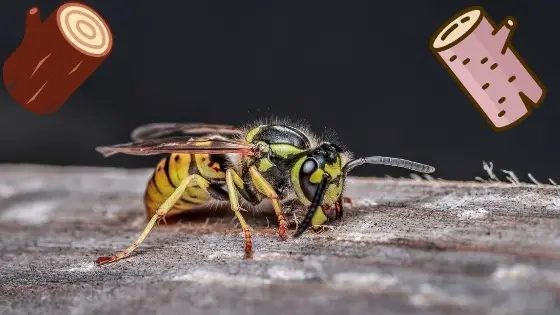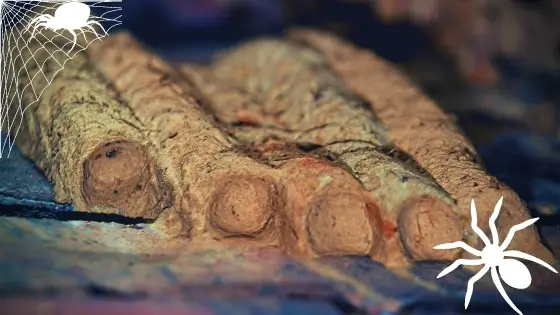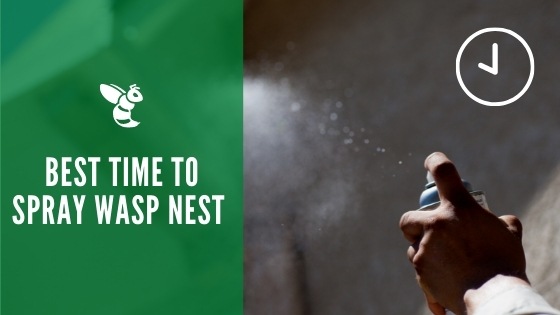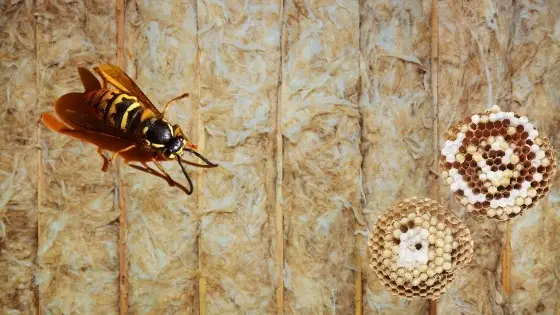Do Wasps Eat Wood?

There are thousands of different species of wasps on the planet, and many of them have the ability and preference to chew on wood. This process is called girdling, and it is used to create cellulose for nests. If you’re wondering what types of wasps eat wood, yellow jackets, potter wasps, horntail wasps, and the European hornet are the most common wasps in the U.S., and they all chew on wood.
If you are noticing a wasp problem on your property that is resulting in wasps chewing on your fence or deck, do you know how to repel wasps from wood? Let’s discuss this topic in more detail.
Chewing & Feeding on Wood
Your typical wasp in the U.S. will be about one inch long, and they’ll have rings of yellow and black on their body. They can easily be mistaken for a bee, but these yellow jackets and paper wasps are actually part of the wasp family. If you’re in another part of the world, wasps may look very different.
A queen will usually dictate to the worker wasps that a nest needs to be constructed. This is when chewing of wood will begin. If they become aggressive because of someone trying to disrupt this process, they have the ability to sting.
When a wood wasp is in the larvae stage, it feeds on wood as their food. Softer woods make the best diet during those early days. As they age, they will be able to move on to harder woods.
The wood wasp can actually make their meal out of just about anything. They get into the habit of chewing, and they can create some pretty unsightly holes in areas like your patio, deck, fence, wallboards, and hardwood floors.
What are Wood Boring Wasps and Do They Sting?
The horntail wasp commonly nests inside of wood, such as trees. They burrow so deep into the wood, and they can actually be transported from one location to the next while still inside of a piece of processed wood. Luckily, they don’t have the ability to sting a human. The worst damage they’re going to cause is holes in the wood structure of your home, deck, etc. Their appearance is blue to black or red to brown with red or yellow markings.
How to Repel Wasps from Your Home and Property
Now that you know why yellow jackets are attracted to wood, you can take the appropriate steps that are needed to repel the wasps and prevent them from coming back. Making your property unpleasant for them will cause them to move on to the next location.
There are certain plants and essential oils that you can use to repel wasps naturally. This is beneficial if you are trying to get rid of wasps that are on your deck or nearby your home.
Spearmint is a natural wasp repellent, as is ginger and peppermint. You can use the oils separately in concentrated form, but you can also mix them together for a stronger and more powerful repellent.
Removing a Wasp Nest
If you attempt to get rid of a wasp nest, you are likely to be stung. Their nature of becoming quickly agitated is only going to put you in danger. If you insist on taking care of a wasp nest yourself, you may want to wait until the winter months roll around. The colder temperatures will cause the wasps to be a lot less active than they are in the summer or spring.
Make sure that you dispose of the nest properly so that you’re not putting anyone else at risk. Just because it’s cold doesn’t mean that the wasps aren’t going to come out of their home. Wear protective clothing that will keep you from getting stung. Attempt to remove the nest at night. This is the quietest time of day for all varieties of wasps.
Wasps tend to be very territorial, and they don’t really like seeing another nest in the area where they’re about to build their own location. You can set up a fake wasp nest to mark your spot. The wasps will see the nest and move on to somewhere that they think is available real estate for them to make a home.
Think of those old paper mache projects that you used to do when you were little. Blow up a balloon, and cover it with strips of newspaper dipped in a glue and water mixture.
Because wasps have the ability to sting and wreak havoc on the wood on your property, it’s essential that you get rid of them as soon as you see a problem. If natural methods don’t work, a professional can safely remove their nest and treat the area. It’s important that you don’t let the problem get out of hand. This could result in some permanent damage to your property.
Don’t assume that a small hole here and there isn’t a problem. You’re essentially providing wasps with a method of making a nest. This will lead to more and more wasps and more and more damage.



